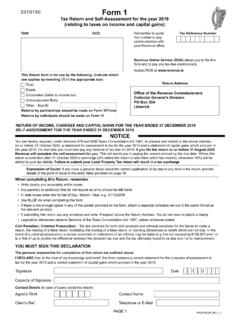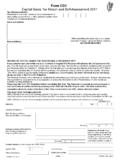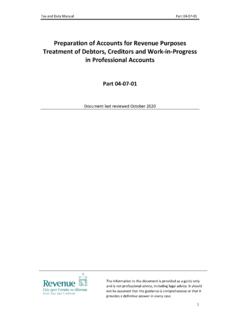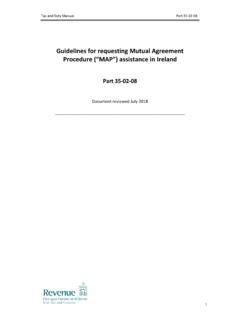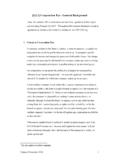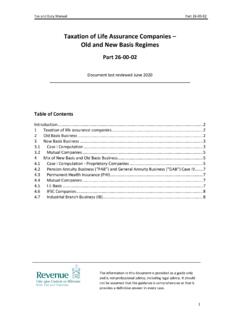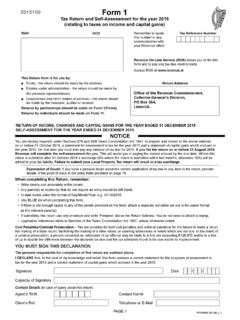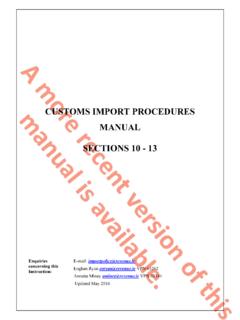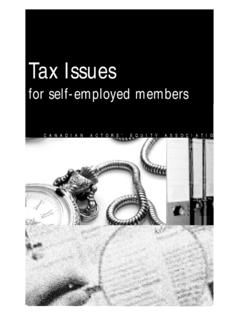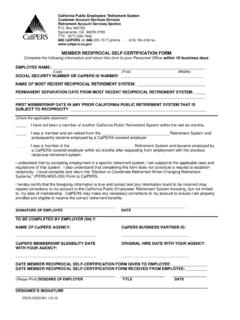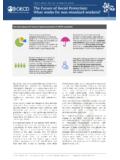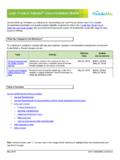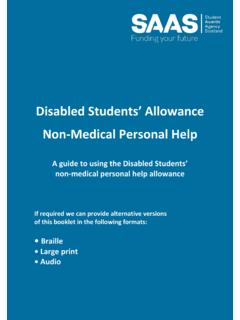Transcription of Code of Practice for Determining Employment or …
1 Code of Practice for Determining Employment or self - Employment Status of Individuals. Code of Practice in Determining Employment status This leaflet was prepared by the Employment Status Group set up under the Programme for Prosperity and Fairness. The group was set up because of a growing concern that there may be increasing numbers of individuals categorised as self employed when the indicators may be that employee status would be more appropriate. The leaflet has been updated in 2007 by the Hidden Economy Monitoring Group under Towards 2016 Social Partnership Agreement. The purpose of the document is to eliminate misconceptions and provide clarity. It is not meant to bring individuals who are genuinely self - employed into Employment status.
2 In most cases it will be clear whether an individual is employed or self - employed . However, it may not always be so obvious, which in turn can lead to misconceptions in relation to the Employment status of individuals. The criteria below should help in reaching a conclusion. It is important that the job as a whole is looked at, including working conditions and the reality of the relationship, when considering the guidelines. An important consideration in this context, will be whether the person performing the work does so as a person in business on their own account . Is the person a free agent with an economic independence of the person engaging the service? This consideration can be a useful indicator of the person s status and should be considered in conjunction with the other criteria listed in this code of Practice .
3 The Safety, Health and Welfare at Work Act, 2005 is the cornerstone of health and safety regulation in Ireland. Employers and Employees all have duties under the act. The legislation treats self - employed persons in a similar manner to employers. It places on them an onus to manage, plan and conduct all work activities to ensure the health and safety of all persons at a workplace. Generally speaking self - employed persons and contractors have a greater responsibility to manage health and safety issues than employees. However, regardless of a person s status, health and safety management and Practice is essential in all work operations. More information is available from Criteria on whether an individual is an employee While all of the following factors may not apply, an individual would normally be an employee if he or she: Is under the control of another person who directs as to how, when and where the work is to be carried out.
4 Supplies labour only. Receives a fixed hourly/weekly/monthly wage. Cannot subcontract the work. If the work can be subcontracted and paid on by the person subcontracting the work,the employer/employee relationship may simply be transferred on. Does not supply materials for the job. Does not provide equipment other than the small tools of the trade. The provision of tools or equipment might not have a significant bearing on coming to a conclusion that Employment status may be appropriate having regard to all the circumstances of a particular case. Is not exposed to personal financial risk in carrying out the work. Does not assume any responsibility for investment and management in the business. Does not have the opportunity to profit from sound management in the scheduling of engagements or in the performance of tasks arising from the engagements.
5 Works set hours or a given number of hours per week or month. Works for one person or for one business. Receives expense payments to cover subsistence and/or travel expenses. Is entitled to extra pay or time off for overtime. Additional factors to be considered: An individual could have considerable freedom and independence in carrying out work and still remain an employee. An employee with specialist knowledge may not be directed as to how the work is carried out. An individual who is paid by commission, by share, or by piecework, or in some other atypical fashion may still be regarded as an employee. Some employees work for more than one employer at the same time. Some employees do not work on the employer s premises. There are special PRSI rules for the Employment of family members.
6 Statements in contracts considered by the Supreme Court in the Denny case, such as You are deemed to be an independent contractor , It shall be your duty to pay and discharge such taxes and charges as may be payable out of such fees to the Revenue Commissioners or otherwise , It is agreed that the provisions of the Unfair Dismissals Act 1977 shall not apply etc , You will not be an employee of this company , You will be responsible for your own tax affairs are not contractual terms and have little or no contractual validity. While they may express an opinion of the contracting parties, they are of minimal value in coming to a conclusion as to the work status of the person engaged. Criteria on whether an individual is self - employed While all of the following factors may not apply to the job, an individual would normally be self - employed if he or she: Owns his or her own business.
7 Is exposed to financial risk by having to bear the cost of making good faulty or substandard work carried out under the contract. Assumes responsibility for investment and management in the enterprise. Has the opportunity to profit from sound management in the scheduling and performance of engagements and tasks. Has control over what is done, how it is done, when and where it is done and whether he or she does it personally. Is free to hire other people, on his or her terms, to do the work which has been agreed to be undertaken. Can provide the same services to more than one person or business at the same time. Provides the materials for the job. Provides equipment and machinery necessary for the job, other than the small tools of the trade or equipment which in an overall context would not be an indicator of a person in business on their own account.
8 Has a fixed place of business where materials, equipment etc. can be stored. Costs and agrees a price for the job. Provides his or her own insurance cover public liability cover, etc. Controls the hours of work in fulfilling the job obligations. Additional factors to be considered: Generally an individual should satisfy the self - employed guidelines above, otherwise he or she will normally be an employee. The fact that an individual has registered for self -assessment or VAT under the principles of self -assessment does not automatically mean that he or she is self - employed . An office holder, such as a company director, will be taxed under the PAYE system. However, the terms and conditions may have to be examined by the Scope Section of Department of E mp l o y m en t A f fa i r s a n d Social Protection to decide on the appropriate PRSI Class.
9 It should be noted that a person who is a self - employed contractor in one job is not necessarily self - employed in the next job. It is also possible to be employed and self - employed at the same time in different jobs. In the construction sector, for health and safety reasons, all individuals are under the direction of the site foreman/overseer. The self - employed individual controls the method to be employed in carrying out the work. Consequences arising from the determination of an individual s status The status as an employee or self - employed person will affect: The way in which tax and PRSI is payable to the Collector-General. An employee will have tax and PRSI deducted from his or her income. A self - employed person is obliged to pay preliminary tax and file income tax returns whether or not he or she is asked for them.
10 Entitlement to a number of social welfare benefits, such as unemployment and disability benefits. An employee will be entitled to unemployment, disability and invalidity benefits, whereas a self - employed person will not have these entitlements. Other rights and entitlements, for example, under Employment Legislation. An employee will have rights in respect of working time, holidays, maternity /parental leave, protection from unfair dismissal etc. o A self - employed person will not have these rights and protection. Public liability in respect of the work done. Deciding status - getting assistance Where there are difficulties in deciding the appropriate status of an individual or groups of individuals, the following organisations can provide assistance.
